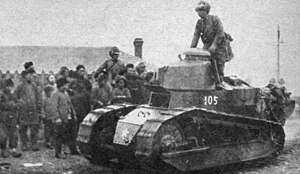Battle of the Nen Jiang Bridge
| date | November 4, 1931 |
|---|---|
| place | Bridge over the Nen Jiang , south of Qiqihar , Manchuria , Republic of China |
| output | Japanese victory |
| Parties to the conflict | |
|---|---|
| Commander | |
| Troop strength | |
| 2,500 soldiers | 800 |
| losses | |
|
120 soldiers |
15 soldiers |
The Battle of the Nen-Jiang Bridge was a minor battle between the Chinese National Revolutionary Army and the Imperial Japanese Army and collaborating Manchurian forces in the wake of the Japanese invasion of Manchuria in the run-up to the Second Sino-Japanese War . It marked the beginning of the Japanese Jiangqiao campaign .
background
At the beginning of November 1931, the ruling governor of Heilongjiang Province , General Ma Zhanshan , decided to disregard the Kuomintang government's ban on resistance to the Japanese occupation of Manchuria. To prevent the Japanese troops from marching into Heilongjiang, Ma decided to stop the Japanese at a strategically important railway bridge over the Nen Jiang River . This had been blown up by Ma’s troops in an earlier battle with the troops of General Zhang Haipeng , who was collaborating with Japan, and was to be rebuilt by the Japanese army to support the advance.
course
On November 4, 1931, a repair force, protected by 800 Japanese soldiers, got to work. A nearby Chinese force of 2,500 soldiers under the command of Ma Zhanshan began to approach the bridge. According to Japanese information, the Chinese troops began bombarding the Japanese with rifles and machine guns in the afternoon when there was thick fog, which they replied. The Chinese side, in turn, accused the Japanese of opening fire for no reason. The fighting lasted about three hours before a Japanese advance across the river forced Mas' troops to retreat. Ma later returned with a considerably larger force, but could not retake the bridge and was again forced to retreat to Tsitsihar . It is not clear whether the Japanese soldiers were supported by tanks and artillery.
consequences
The Japanese were able to repair the bridge and thus significantly accelerate the advance of their troops and armored trains.
Despite his defeat in the battle for the bridge, Ma Zhanshan was branded a hero by the Chinese and international press for daring to stand in the way of the Japanese advance from Nanjing without backing . After the battle, there was an increased influx of volunteers into the anti-Japanese volunteer armies in Manchuria. While these troops were not a real threat to the Japanese advance, they did pose a serious problem in pacifying Manchukuo during 1932 .
See also
literature
- Anthony Coogan: Northeast China and the Origins of the Anti-Japanese United Front . In: Modern China , Vol. 20 (1994), Issue 3, pp. 282-314, ISSN 0097-7004
- Yoshihisa Tak Matsusaka: The Making of Japanese Manchuria, 1904-1932 . Harvard University Asia Center, Cambridge, Mass. 2003, ISBN 0-674-00369-1 (Harvard East Asia Monographs; 196).
Web links
- Two Warlords Issue of TIME Magazine November 16, 1931
- NONNI BRIDGE
- Northeast China's Volunteer Armies
